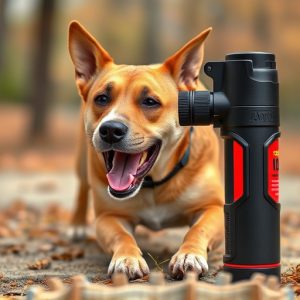Canine Pepper Spray Defense: Distance, Strategy, and Debunked Myths
The "Canine Pepper Spray Deployment Distance Guide" is essential for responsible and legal…….
The "Canine Pepper Spray Deployment Distance Guide" is essential for responsible and legal self-defense against aggressive dogs, with an effective range of 2-3 meters. Adhering to this guide ensures optimal spray deployment, safety, and legality, influenced by factors like wind, terrain, target size, and behavior. Understanding these variables strengthens legal defenses and enhances operational safety. The effectiveness and legality of canine pepper spray are debated, but case studies illustrate successful deployments when used strategically based on conditions and physiology.
In today’s world, understanding the legal implications of canine pepper spray (mace dog spray) is crucial for both law enforcement and citizens alike. This comprehensive guide explores the deployment distance and key considerations surrounding this powerful tool. We delve into building a robust legal defense strategy, backed by real-world case studies and debunking common misconceptions. By examining these aspects, users gain valuable insights into navigating the legal landscape of canine pepper spray deployment distance.
- Understanding Mace Dog Spray and Its Legal Implications
- Canine Pepper Spray Deployment Distance: Key Considerations
- Building a Strong Legal Defense Strategy
- Case Studies and Common Misconceptions Debunked
Understanding Mace Dog Spray and Its Legal Implications
Mace dog spray, also known as canine pepper spray, is a non-lethal self-defense tool designed to incapacitate an attacker by temporarily blinding and disorienting them. It’s a powerful defense mechanism for individuals facing aggressive dogs, offering a safe alternative to lethal force. The legal implications of using mace dog spray are complex and vary greatly depending on jurisdiction.
Understanding the deployment distance guide is crucial. Canine pepper spray typically has a range of 2-3 meters (6-10 feet), beyond which its effectiveness diminishes significantly. This knowledge is key to ensuring responsible use, as it helps individuals employ the spray only when necessary and within legal boundaries. Unlawful or excessive use can result in serious consequences, including fines, lawsuits, and even criminal charges.
Canine Pepper Spray Deployment Distance: Key Considerations
When considering a Canine Pepper Spray Deployment Distance Guide, it’s crucial to understand that the effectiveness and safety of pepper spray rely heavily on proper application. The optimal range for deploying canine pepper spray is typically between 2 to 4 meters (6.5 to 13 feet). Exceeding this distance can lead to reduced potency and potential missed targets, as the spray dissipates quickly in the air. On the other hand, aiming too close may result in over-exposure of both the targeted individual and the handling officer’s own eyes and respiratory system.
Several factors influence the ideal deployment distance, including wind conditions, terrain, and the size and behavior of the target. In open spaces with minimal obstructions, the spray can reach further, whereas confined areas like alleys or narrow passages may require a shorter range. Understanding these variables is essential for legal defense, as demonstrating appropriate use within recommended parameters can strengthen an officer’s case in potential legal challenges related to pepper spray deployment.
Building a Strong Legal Defense Strategy
When mounting a legal defense against charges related to canine pepper spray deployment, understanding the context and specifics is paramount. One key element to focus on is the Canine Pepper Spray Deployment Distance Guide. This guide provides crucial information on the effective range of pepper spray when used by law enforcement dogs, which can significantly impact the strength of your defense. By examining the circumstances surrounding the incident, including distance from the subject, usage protocols, and training records, legal counsel can build a robust argument.
Additionally, gathering evidence to challenge the prosecution’s narrative is essential. This might include expert testimony on proper deployment procedures, documentation of any prior incidents or misuses of pepper spray, and witness accounts that contradict the claimed distances or circumstances. A well-prepared defense should also consider the legal precedents and jurisdiction-specific laws related to canine pepper spray use, ensuring a comprehensive strategy tailored to the unique aspects of each case.
Case Studies and Common Misconceptions Debunked
In the realm of law enforcement tactics, discussions around canine pepper spray often revolve around its effectiveness and legality. To clarify common misconceptions, it’s crucial to examine case studies that highlight successful and unsuccessful deployments. Contrary to a popular belief, there is no one-size-fits-all approach when it comes to the deployment distance of canine pepper spray. The Canine Pepper Spray Deployment Distance Guide offers valuable insights into optimal usage, suggesting distances based on factors like wind speed, terrain, and the specific spray’s properties.
Case studies reveal that when used appropriately, pepper spray can be a game-changer in high-risk situations. For instance, in scenarios involving aggressive or unpredictable suspects, officers have reported successful subdues at varying distances, proving its versatility. However, misconceptions often arise from misapplications or misuse, leading to debates about its efficacy. Debunking these myths requires understanding the science behind pepper spray and its interactions with human physiology, as well as the strategic considerations for optimal deployment, making it a critical aspect of law enforcement training.
Understanding the legal implications of canine pepper spray, especially its deployment distance, is crucial for both law enforcement agencies and individuals seeking defense against such actions. This guide has provided insights into the key considerations surrounding deployment distance, emphasizing the importance of context and proportionality. By building a robust legal defense strategy, as outlined in this article, one can navigate these complex issues effectively. Remember, knowledge is power, and being informed about your rights and the potential for misapplication of force is essential to ensuring justice.


